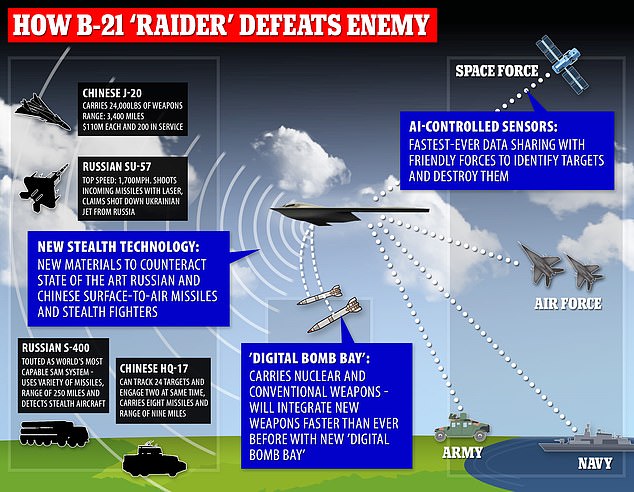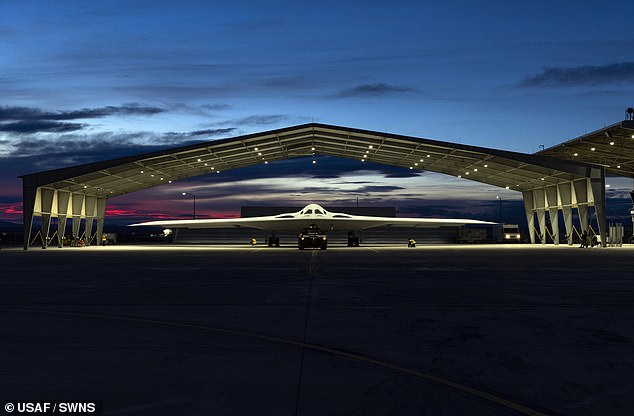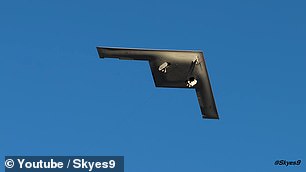America’s secretive $745M nuclear bomber takes flight in first aerial test
New images show America’s top-secret, $745 million stealth nuclear bomber taking to the skies for what is apparently its first publicly acknowledged test flight.
The B-21 Raider was unveiled in December 2022, but the US government has thus far been discreet in showing off this advanced, radar-evading aircraft.
The sleek bomber was shown flying for the first time as it underwent flight testing in photos released Wednesday, a crucial step before a minimum initial order of 100 of the stealth craft can be approved for production.
The B-21 is described as a ‘dual-capable bomber’ – capable of launching both conventional and nuclear ordinances.
This photo released by the United States Air Force on May 22, 2024 shows a B-21 Raider conducting ground testing, taxiing and flight operations at Edwards Air Force Base in California

The US Air Force’s B-21 stealth bomber aircraft is touted to be virtually ‘invisible’ to all enemy stealth radars and will feature the latest in military technology
This month, Andrew Hunter, the assistant secretary of the Air Force for Acquisition, Technology and Logistics, claimed during testimony before the Senate Armed Services Committee that the B-21’s test flights are currently on schedule.
“We are in the flight test program, the flight test program is going well,” he said.
“It does what flight test programs are designed to do, which helps us learn the unique characteristics of this platform, but in a very, very effective way.”
Assistant Secretary Hunter later explained that this is the first aircraft that is more digital than not, which helps meet the requirements of the program.

The US Air Force’s new stealth bomber was first seen in action by eagle-eyed plane spotters last November, but made a more official test flight in May
The B-21 is a long-range, highly survivable and penetrating stealth bomber that will incrementally replace the B-1 and B-2 bombers and play an important role in supporting national security objectives and assisting U.S. allies and partners around the world.
The B-21 weapon system is manufactured under the Air Force’s contract with Northrop Grumman.
“It is designed with an open systems architecture, allowing rapid integration of mature technologies and allowing the aircraft to remain effective as threats evolve over time,” the U.S. Air Force said.
“The aircraft is expected to enter service in the mid-2020s with a production target of at least 100 aircraft,” the military branch continued in their statement.

The B-21 taxiing at Edwards Air Force Base, California
The B-21 Raider is a nuclear-capable aircraft and the first of its kind to be introduced since the end of the Cold War.
Although press reports described the recent test flights as the first of the B-21, the B-21 was previously spotted during a test flight in California late last year, as confirmed by Air Force officials.
Aviation photographer Matt Hartman caught the new fighter in action at Northrop Grumman’s Palmdale facility in November 2023, recording video of this less public test flight from a road near Air Force Plant 42 Palmdale, California.

Aviation photographer Matt Hartman captured the new fighter in action last November at the Northrop Grumman facility in Palmdale and captured video of a less official test flight
His footage shows the uniquely shaped B-21 Raider hurtling through the sky, flanked by another aircraft, before taking a sharp turn.
Six test aircraft are being produced by aerospace company Northrop Grumman and each is expected to cost $750 million.
It is touted to be virtually ‘invisible’ to all enemy stealth radars and will be equipped with the latest features in military technology.
The B-21 Raider weighs approximately 30,000 pounds, has a wingspan of 50 meters and can reach a maximum speed of 1,000 kilometers per hour.
Thomas A. Bussier, commander of Air Force Global Strike, called the aircraft the “future backbone of the bomber fleet” during an unveiling event in November.
In the long term, the U.S. Air Force hopes to have at least 220 to replace the aging B-1 and B-2 bombers.
The service estimates that the program will likely cost at least $203 billion over the next 30 years to develop, acquire and maintain the B-21 fleet.
The B-21 is part of the Pentagon’s efforts to modernize all three pillars of its nuclear triad, which also includes silo-launched nuclear ballistic missiles and submarine-launched nuclear warheads, as it shifts from the counterterrorism campaigns of recent decades to the fast Chinese army. modernization.
